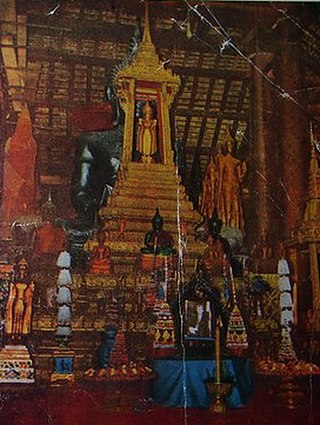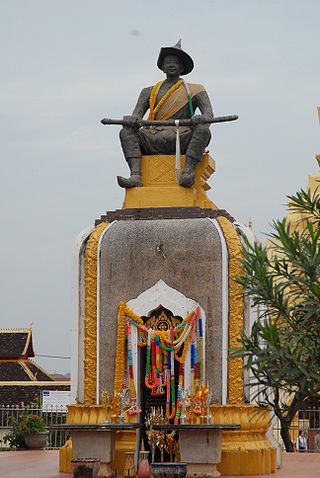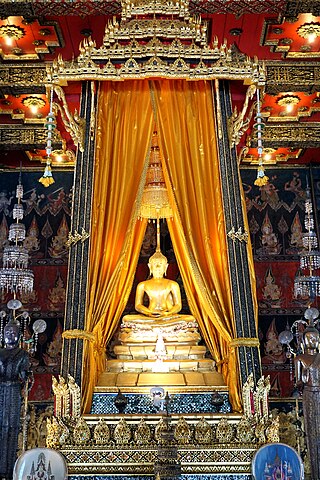
Evidence for modern human presence in the northern and central highlands of Indochina, that constitute the territories of the modern Laotian nation-state dates back to the Lower Paleolithic. These earliest human migrants are Australo-Melanesians—associated with the Hoabinhian culture—and have populated the highlands and the interior, less accessible regions of Laos and all of South-east Asia to this day. The subsequent Austroasiatic and Austronesian marine migration waves affected landlocked Laos only marginally and direct Chinese and Indian cultural contact had a greater impact on the country.

Wat Xieng Thong is a Buddhist temple on the northern tip of the peninsula of Luang Phrabang, Laos. Built between 1559 and 1560 by King Setthathirath, Wat Xieng Thong is one of the most important of Lao monasteries and remains a significant monument to the spirit of religion, royalty and traditional art.

The Emerald Buddha is an image of the meditating Gautama Buddha seated in a meditative posture, made of a semi-precious green stone, clothed in gold. and about 66 centimetres (26 in) tall. The image is considered the sacred palladium of Thailand. It is housed in the Temple of the Emerald Buddha on the grounds of the Grand Palace in Bangkok.

The Phra Bang, Lao is the palladium of Laos. The Lao-language name for the image has been transliterated in a number of ways, including "Pra Bang," "Prabang," "Phabang" and "Pha Bang." The statue is an 83 cm-high standing Buddha with palms facing forward, cast using thong, an alloy of bronze, gold, and silver. According to local lore, it was cast in Ceylon sometime between the 1st and 9th century. However, the features of the image suggest a much later Khmer origin.

Lao art involves the myriad of forms creative, cultural expression originating from Laos. This includes both ancient artifacts and recent productions. Laotian Art often features Buddhist themes and includes such material forms as textiles, wood-carving and basket-weaving. Lao art is well known for its wealth of ornamentation

Nong Khai is a city in northeast Thailand. It is the capital of Nong Khai province. Nong Khai city is located in Mueang Nong Khai district.

Laos developed its culture and customs as the inland crossroads of trade and migration in Southeast Asia over millennia. As of 2012 Laos has a population of roughly 6.4 million spread over 236,800 km2, yielding one of the lowest population densities in Asia. Yet the country of Laos has an official count of over forty-seven ethnicities divided into 149 sub-groups and 80 different languages. The Lao Loum have throughout the country's history comprised the ethnic and linguistic majority. In Southeast Asia, traditional Lao culture is considered one of the Indic cultures.

'Phra Lak Phra Ram' is the national novel of the Lao people, and is the Lao adaptation of the Dasaratha Jataka, a story narrating one of the previous life of Buddha as a Bodhisatta named Rama. It was brought to Laos and other Southeast Asia by propagation of Buddhism. The story reached Laos much later than Cambodia and Thailand (Siam) and thus was affected by local adaptation.

Haw Phra Kaew, also written as Ho Prakeo, Hor Pha Keo and other similar spellings, is a former temple in Vientiane, Laos. It is situated on Setthathirath Road, to the southeast of Wat Si Saket. It was first built in 1565 to house the Emerald Buddha, but has been rebuilt several times. The interior now houses a museum of religious art and a small shop.

Buddha Park, also known as Xieng Khuan, is a sculpture park 25 km southeast from Vientiane, Laos in a meadow by the Mekong River. Although it is not a temple (Wat), it may be referred to as Wat Xieng Khuan since it contains numerous religious images. The name Xieng Khuan means Spirit City. The park contains over 200 Hindu and Buddhist statues. The socialist government operates Buddha Park as a tourist attraction and public park.

A Buddha image in Thailand typically refers to three-dimensional stone, wood, clay, or metal cast images of the Buddha. While there are such figures in all regions where Buddhism is commonly practiced, the appearance, composition and position of the images vary greatly from country to country in Buddhist art.

A wat is a type of Buddhist temple and Hindu temple in Cambodia, Laos, East Shan State, Yunnan, the Southern Province of Sri Lanka and Thailand. The word wat is a Thai word that was borrowed from Sanskrit vāṭa, meaning 'enclosure'. The term has varying meanings in each region, sometimes referring to a specific type of government-recognised or large temple, other times referring to any Buddhist or Hindu temple.

Vientiane is the capital and largest city of Laos. Comprising the five urban districts of Vientiane Prefecture, the city is located on the banks of the Mekong, right at the border with Thailand. Vientiane was the administrative capital during French rule and, due to economic growth in recent times, is now the economic center of Laos. The city had a population of 1,001,477 as of the 2023 Census.

Wat Ong Teu Mahawihan is one of many Buddhist monasteries in the city of Vientiane in Laos. This name is given to the temple due to the large, bronze Phra Ong Teu Buddha image that is in the temple: the largest Buddha in Vientiane. This temple was initially constructed by King Setthathirath I in the 16th century when Laos was being bombarded by the Burmese, but was later demolished during a foreign invasion. Thus, it may have gone through many reconstructions during the 19th or 20th century to attain the appearance it has today.

Vientiane is a prefecture of Laos, in the northwest Laos. The national capital, Vientiane, is in the prefecture. The prefecture was created in 1989, when it was split off from Vientiane province.

Luang Prabang is a province in northern Laos. Its capital of the same name, Luang Prabang, was the capital of the Lan Xang Kingdom during the 13th to 16th centuries. It is listed since 1995 by UNESCO as a World Heritage Site for unique architectural, religious and cultural heritage, a blend of the rural and urban developments over several centuries, including the French colonial influences during the 19th and 20th centuries. The province has 12 districts. The Royal Palace, the national museum in the capital city, and the Phou Loei Protected Reserve are important sites. Notable temples in the province are the Wat Xieng Thong, Wat Wisunarat, Wat Sen, Wat Xieng Muan, and Wat Manorom. The Lao New Year is celebrated in April as The Bun Pi Mai.

The Phra Phuttha Sihing is a highly revered image of the Gautama Buddha in Bangkok, Thailand, second in importance only after the Emerald Buddha. The image is currently housed at the Phutthaisawan Hall, now the Bangkok National Museum. The image was brought to Bangkok from Wat Phra Singh, Chiang Mai in 1795 by Viceroy Maha Sura Singhanat, the brother of King Rama I.

Lao–Siamese War or the Siamese Invasion of Laos (1778–1779) is the military conflict between Thonburi Kingdom of Siam and the Lao kingdoms of Vientiane and Champasak. The war resulted in all three Lao kingdoms of Luang Phrabang, Vientiane and Champasak becoming Siamese tributary vassal kingdoms under Siamese suzerainty and domination in Thonburi and the subsequent Rattanakosin Period.

Wat Kharuehabodi is a Thai Buddhist temple by the Chao Phraya river in the Thonburi's Bang Phlat district, Bangkok.


























